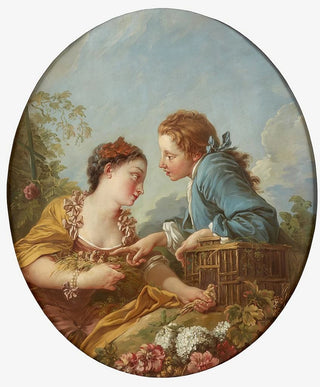Art print | The Bird Nesters - François Boucher School


View from behind

Frame (optional)
In the vast panorama of art history, certain works stand out for their ability to capture the very essence of nature and human relationships. "Les Oiseaux Nicheurs," an iconic art print from the École de François Boucher, embodies this delicate harmony between the animal world and the human world. This piece, rich in colors and emotions, transports us to a universe where everyday softness blends with the wild beauty of nature. Every detail, every color, and every gesture of the characters evoke an atmosphere of serenity and wonder, inviting us to contemplate life from a poetic and enchanting perspective.
Style and uniqueness of the work
Boucher's style is often associated with rococo, an artistic movement that favors elegance, lightness, and sensuality. In "Les Oiseaux Nicheurs," this signature is expressed through graceful curves and dynamic compositions. The color palette, dominated by pastel shades and soft nuances, creates a soothing, almost dreamlike ambiance. The characters, engaged in delicate observation and care activities, are depicted with such finesse that they seem almost alive. Light plays a fundamental role in this art print, highlighting textures and details while creating an intimate atmosphere. The composition encourages the viewer to wander through the scene, gradually discovering the richness of the natural elements surrounding it.
The artist and his influence
François Boucher, born in 1703, is one of the most emblematic artists of 18th-century France. A student of François Le Moyne, he quickly developed a style that was uniquely his own, blending classical influences with baroque elements. Boucher is also known for his portraits and mythological scenes, but it is in his depictions of daily life and nature that he truly excels. His influence extends beyond his era, inspiring many artists and later movements. By incorporating themes of domestic life and nature, Boucher managed to establish a link between art and reality, paving the way for generations of artists who sought to explore this relationship.

Matte finish

View from behind

Frame (optional)
In the vast panorama of art history, certain works stand out for their ability to capture the very essence of nature and human relationships. "Les Oiseaux Nicheurs," an iconic art print from the École de François Boucher, embodies this delicate harmony between the animal world and the human world. This piece, rich in colors and emotions, transports us to a universe where everyday softness blends with the wild beauty of nature. Every detail, every color, and every gesture of the characters evoke an atmosphere of serenity and wonder, inviting us to contemplate life from a poetic and enchanting perspective.
Style and uniqueness of the work
Boucher's style is often associated with rococo, an artistic movement that favors elegance, lightness, and sensuality. In "Les Oiseaux Nicheurs," this signature is expressed through graceful curves and dynamic compositions. The color palette, dominated by pastel shades and soft nuances, creates a soothing, almost dreamlike ambiance. The characters, engaged in delicate observation and care activities, are depicted with such finesse that they seem almost alive. Light plays a fundamental role in this art print, highlighting textures and details while creating an intimate atmosphere. The composition encourages the viewer to wander through the scene, gradually discovering the richness of the natural elements surrounding it.
The artist and his influence
François Boucher, born in 1703, is one of the most emblematic artists of 18th-century France. A student of François Le Moyne, he quickly developed a style that was uniquely his own, blending classical influences with baroque elements. Boucher is also known for his portraits and mythological scenes, but it is in his depictions of daily life and nature that he truly excels. His influence extends beyond his era, inspiring many artists and later movements. By incorporating themes of domestic life and nature, Boucher managed to establish a link between art and reality, paving the way for generations of artists who sought to explore this relationship.






